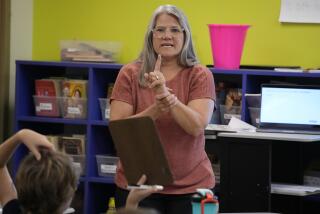The ‘Why’ of Math
- Share via
If American kids want to compete in the global economy with the graduates of Japanese and Chinese schools, they need more math drills, right?
Not according to an intriguing international study of math classes. Taking the simple but rare step of watching math teachers at work, this study, directed by a UCLA psychology professor, finds some surprising things going on in the classroom and reveals the value of balancing a back-to-basics curriculum with an emphasis on deeper thinking abilities.
Videotapes of eighth-grade math teachers at work found that U.S. teachers spent a lot of time instructing students in how to solve math problems. So did teachers in areas of the world that outrank the U.S. in international math exams, such as Japan, Hong Kong and the Netherlands. But one difference marked U.S. schools: Teachers here were less likely to teach the concepts behind the mechanics, or even explain how they reached a math solution. Put in the simplest terms, U.S. students learn how to turn the fraction 3/4 into 75%, but they are less likely to learn that the process works because of the principles governing ratios.
Teachers in Japan helped students use concepts to think their way through tough math problems. Teachers in Hong Kong were more likely to lecture about the concept itself. The style didn’t matter, study director James W. Stigler says. More important was that instructors unlocked the logic within mathematics and helped students make connections between ideas and procedures.
Does this mean U.S. schools should embrace the feel-good days of math taught solely through hands-on activities? Definitely not. Students might have enjoyed playing with beads, but they learned few principles of math that way and no math procedures.
“Numeracy” is a must, yet more is needed to compete with the best in the world. There must be teachers who fully understand their material and can communicate that understanding. Close to a third of U.S. math teachers lack a major or minor in the subject and, Stigler says, they receive little training in the teaching of concepts.
The lesson in the study also applies to poor reading and writing skills. Schools have made a good start by returning to phonics to teach the mechanics of reading. But that alone won’t make students able to read deeply for content or to form their own well-expressed sentences.
This could be one reason why fourth-graders in California continue to do poorly on a national reading test, as the U.S. Department of Education reported this month. Scores also tend to flatten at this age on the California standards test. At the fourth-grade level, both tests examine students’ ability to interpret reading passages and write about what they have read, rather than focusing on decoding words.
Even when phonics and multiplication tables were the subject of jokes, great teachers never fully dropped them. Nor do great teachers now ignore literature-based reading or the “why” of math. Sound education policy encourages balance in the classroom rather than wild pendulum swings.
More to Read
Sign up for Essential California
The most important California stories and recommendations in your inbox every morning.
You may occasionally receive promotional content from the Los Angeles Times.













